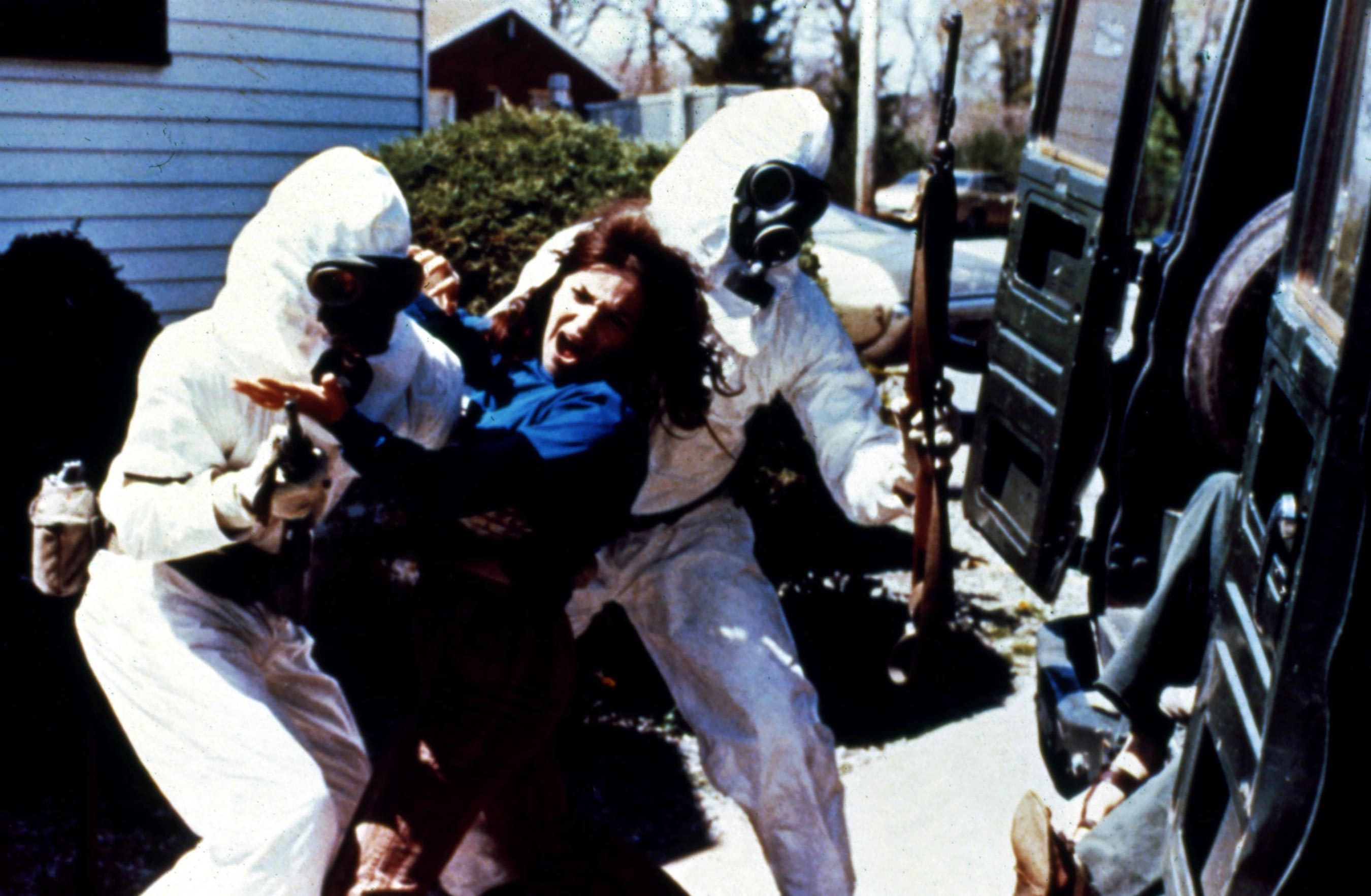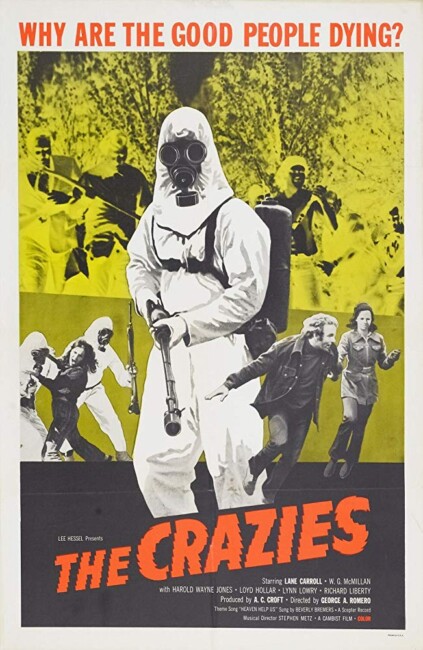aka Code Name: Trixie
USA. 1973.
Crew
Director/Screenplay – George A. Romero, Story – Paul McCollough, Producer – Alvin C. Croft, Photography – S. William Hinzman, Music – Bruce Roberts, Special Effects – Tony Pantanello & Regis Survinski. Production Company – Cambist.
Cast
W.G. MacMillan (David), Harold Wayne Johns (Clank), Lloyd Hollar (Colonel Peckem), Lane Carroll (Judy), Richard France (Dr Watts), Lynn Lowry (Kathie), Richard Liberty (Artie), Marry Spillman (Major Ryder), Will Disney (Dr Brookmayre)
Plot
Soldiers arrive in Evans City, Pennsylvania, where they quickly establish martial law and round up the populace in the high school. It is revealed that a plane containing a viral bio-weapon went down in the area a few days ago. The effects of the virus drive people insane and it has sunken down into the Artesian Wells and infected the town’s water system. Many of the townspeople start to become infected. A group of friends try to escape to freedom as the military close in but their escape attempt is upset from within as members of the group start to succumb to the virus’s effects.
Prior to making The Crazies, George Romero had made the consequential Night of the Living Dead (1968), which became a midnight cult classic. In the next decade-and-a-half, Romero would go on to establish himself as a strong and intelligent genre director with the likes of Martin (1976), Dawn of the Dead (1978), Creepshow (1982) and Day of the Dead (1985). In the few years immediately after Night of the Living Dead though, Romero floundered about trying to find his feet. He made two other films, the romance There’s Always Vanilla (1971) and the suburban witchcraft effort Jack’s Wife/Season of the Witch/Hungry Wives (1972). The Crazies was his fourth film. It was also George Romero’s first reasonable sized budget, although The Crazies itself was not at all a big success. Many people at the time dismissed The Crazies for not being Night of the Living Dead but it is far too good a film for that. It is one George Romero work that is seriously worthy of re-evaluation.
Most of George Romero’s films operate as survivalist horror films – where protagonists are forced to confront the nightmare of a world suddenly turned on its head. In The Crazies, Romero propels us into the nightmare with a grim urgency. The military operation and escape scenes have a gritty realism in their setting up and detailing. Crises are compounded and frustrated, and during these scenes the plot moves with engrossing regard. The shootouts between soldiers and crazies are handled with an admirable large-scaled flair.
Romero plays some good shock images – like the grandmother who sits knitting and then smilingly turns to stab one of her needles into an inquiring soldier; the priest setting himself on fire; or the little child watching as her mother is shot and then torched by soldiers. However, the most impressive images in the film are the internal psychological horrors – the subtlety that comes in watching the party’s inner weakening – of the gung ho relish with which Harold Wayne Johns starts shooting up soldiers, or when Richard Liberty starts raving about protecting his daughter from men and is then found trying to fuck her himself, and how she starts flirting with the ring of soldiers who simply shoot her when she refuses to stop.

There is an opening reminiscent of Night of the Living Dead where Romero plays the same “the monsters are going to get you” prank with a couple of children, although it is not as adroit a black joke this time around. Far better are the dark twists that Romero manages in the ending, where he seemingly tries to duplicate the black irony of Duane Jones’s shooting at the end of Night of the Living Dead – W.G. MacMillan disguises himself in a vac suit to get past the soldiers, only to be shot at by crazies thinking he is a real soldier and then thrown in the high-school – the only person with a natural immunity – but dismissed by the medics “Shall we check this one for immunities?” “Are you kidding?” and where the only person who does discover an antidote is caught up in the red tape and shot thought to be a rioter.
The film has the forcedly hesitant acting of an amateur cast, particularly in the opening bedroom scenes, but George Romero keeps things busy enough for such not to become too noticeable. Once the film has gotten going, the likes of Richard France, Lloyd Hollar and Marry Spillman turn in a number of good, hard-edged performances. This is one of George Romero’s best films, one that holds a muchly underrated maturity of theme and execution.
Amid the 00s penchant of remakes of 1970s/80s horror films, a remake was conducted under director Breck Eisner as The Crazies (2010) with George Romero acting as an Executive Producer. The mass insanity theme was first used in the Star Trek episode The Naked Time (1966). The madness inducing biospill and/or works about groups of people being affected by mass insanity has been used in a number of other films since including Impulse (1984), Warning Sign (1985), The Signal (2007), Pontypool (2008), Dead Air (2009), Nine Miles Down (2009), YellowBrickRoad (2010), Patient Zero (2012), Urge (2016), Mayhem (2017), Mom & Dad (2017) and The Sadness (2021)
George A. Romero’s other films include the cult favourite Night of the Living Dead (1968); the suburban witchcraft film Jack’s Wife/Season of the Witch/Hungry Wives (1972); The Amusement Park (1975), a surreal allegory about aging; Martin (1976), a superb deconstruction of the cinematic vampire myth; Dawn of the Dead (1978); the Stephen King-scripted horror comic homage Creepshow (1982); Day of the Dead (1985); Monkey Shines (1988) about a psychic link between a paraplegic and a murderous monkey; Two Evil Eyes (1990), an Edgar Allan Poe collaboration with Dario Argento; The Dark Half (1993) from the Stephen King novel about a writer haunted by an evil doppelganger; Bruiser (2000) about a man whose face suddenly becomes a blank mask; Land of the Dead (2005), Diary of the Dead (2007) and Survival of the Dead (2009). Romero has also produced the Tales from the Darkside (1983-5) and Monsters (1988-9) horror anthology series, and the films Deadtime Stories (2009) and Deadtime Stories 2 (2010). His scripts include Creepshow II (1987), Tales from the Darkside: The Movie His scripts include Creepshow II (1987), Tales from the Darkside: The Movie (1990) and the remake of Night of the Living Dead (1990). Also of interest is George A. Romero’s Resident Evil (2025), a documentary about Romero’s unmade Resident Evil film.
Trailer here


